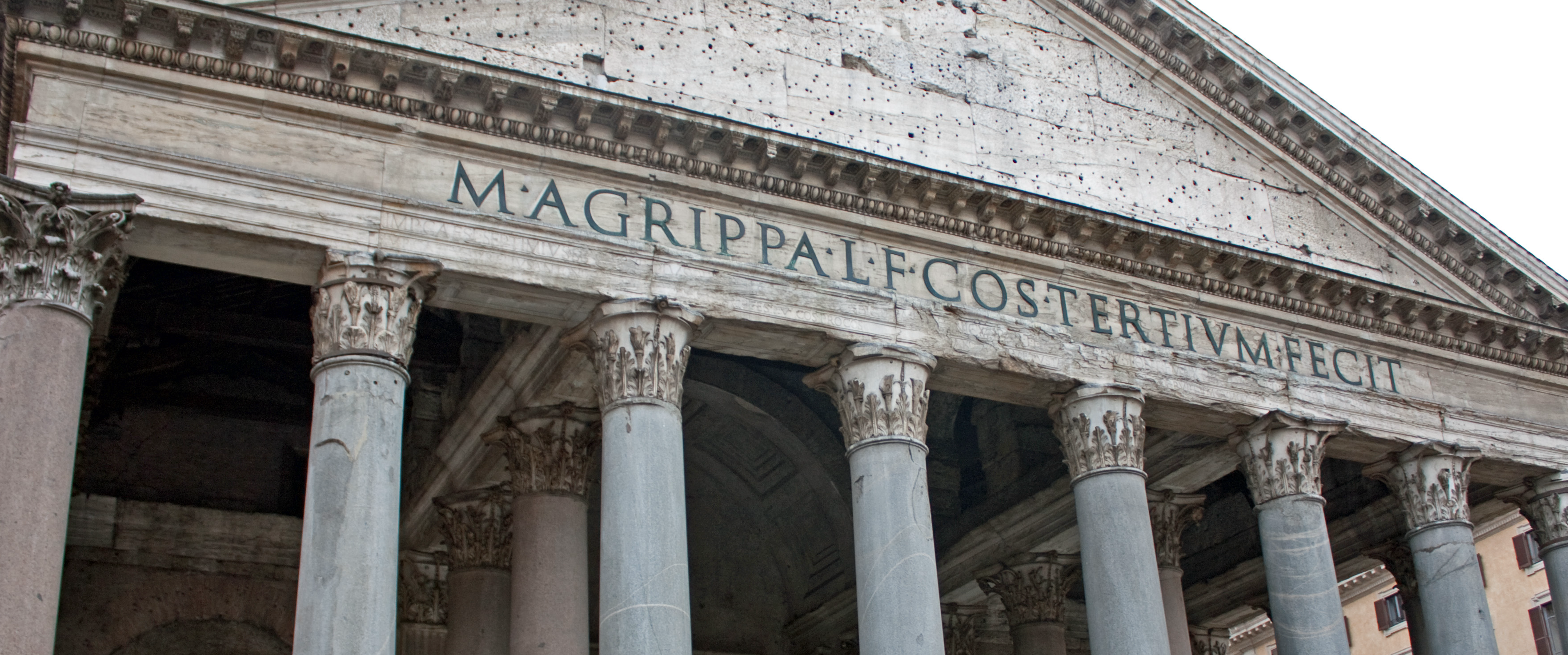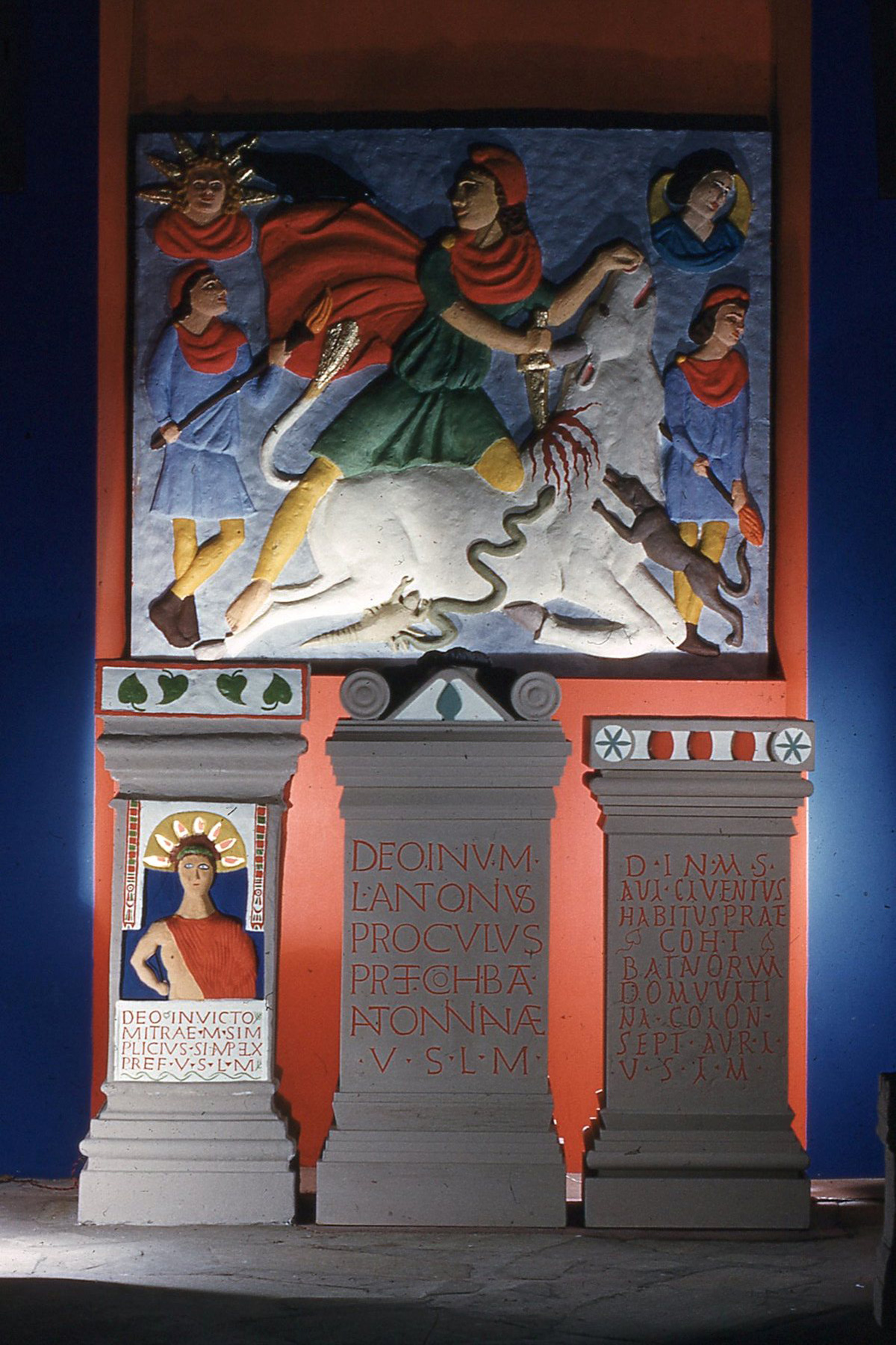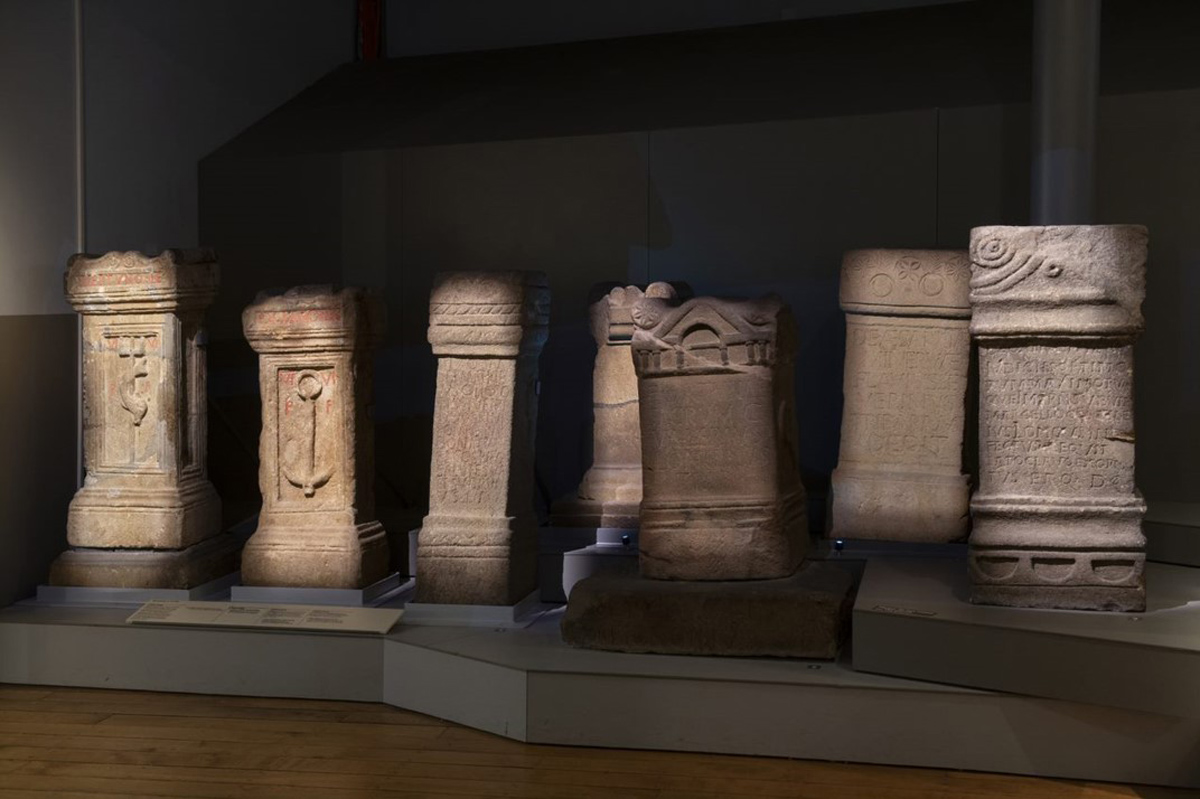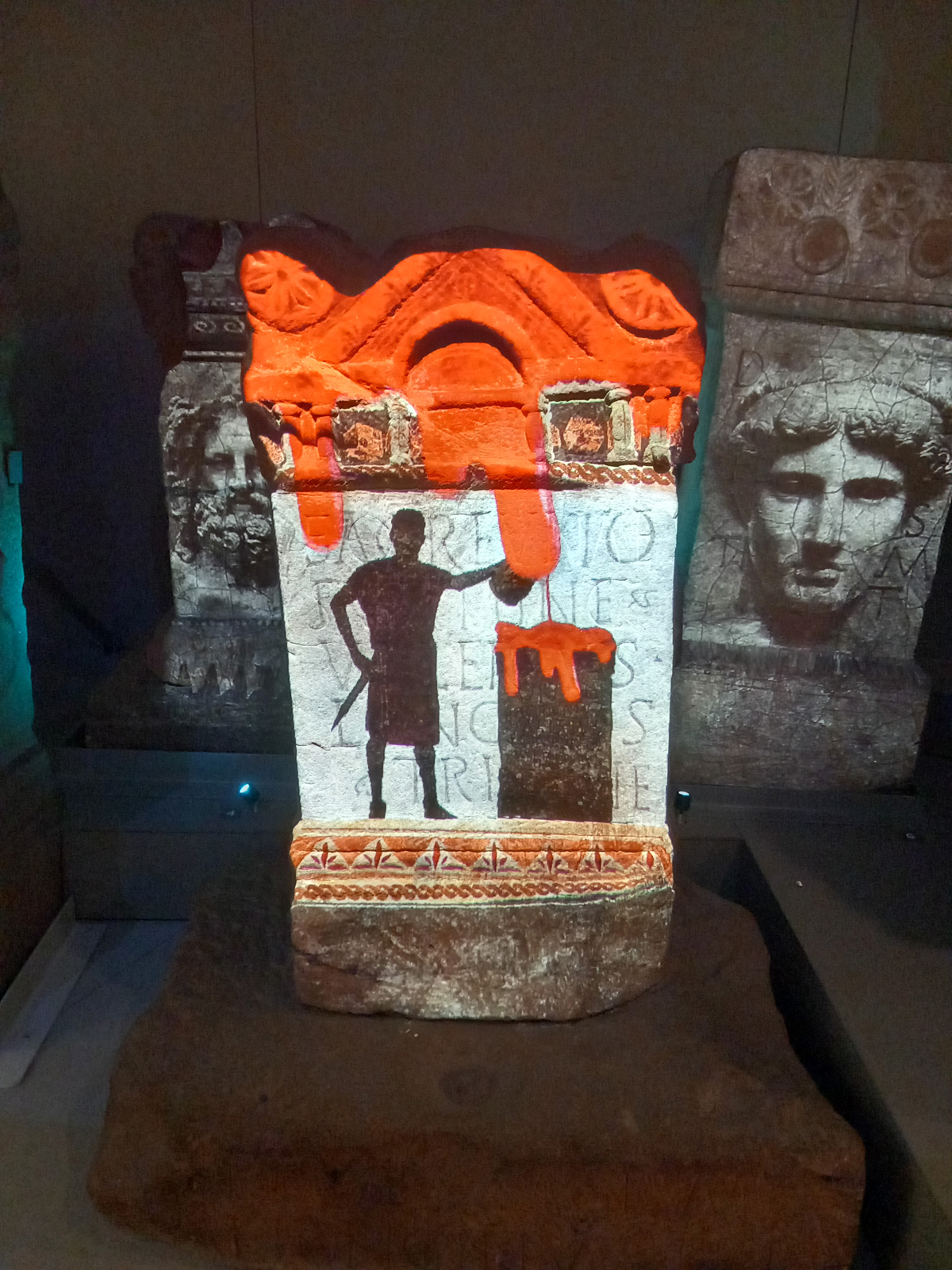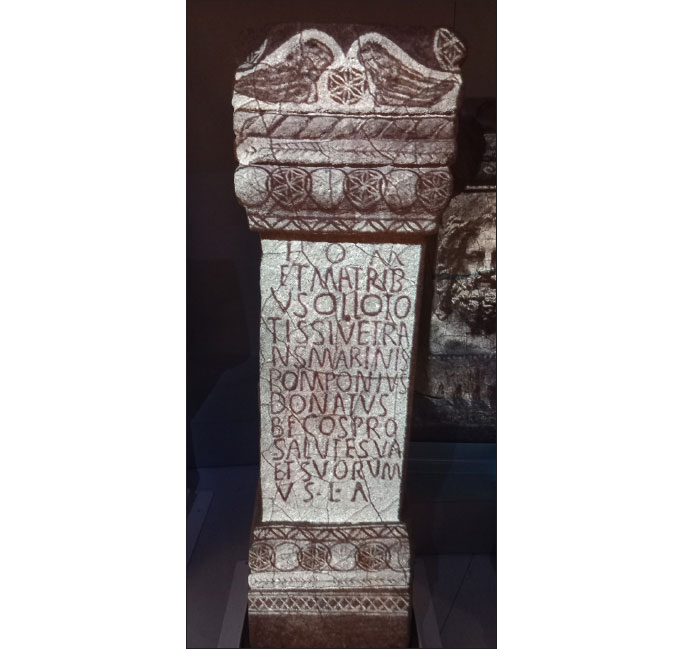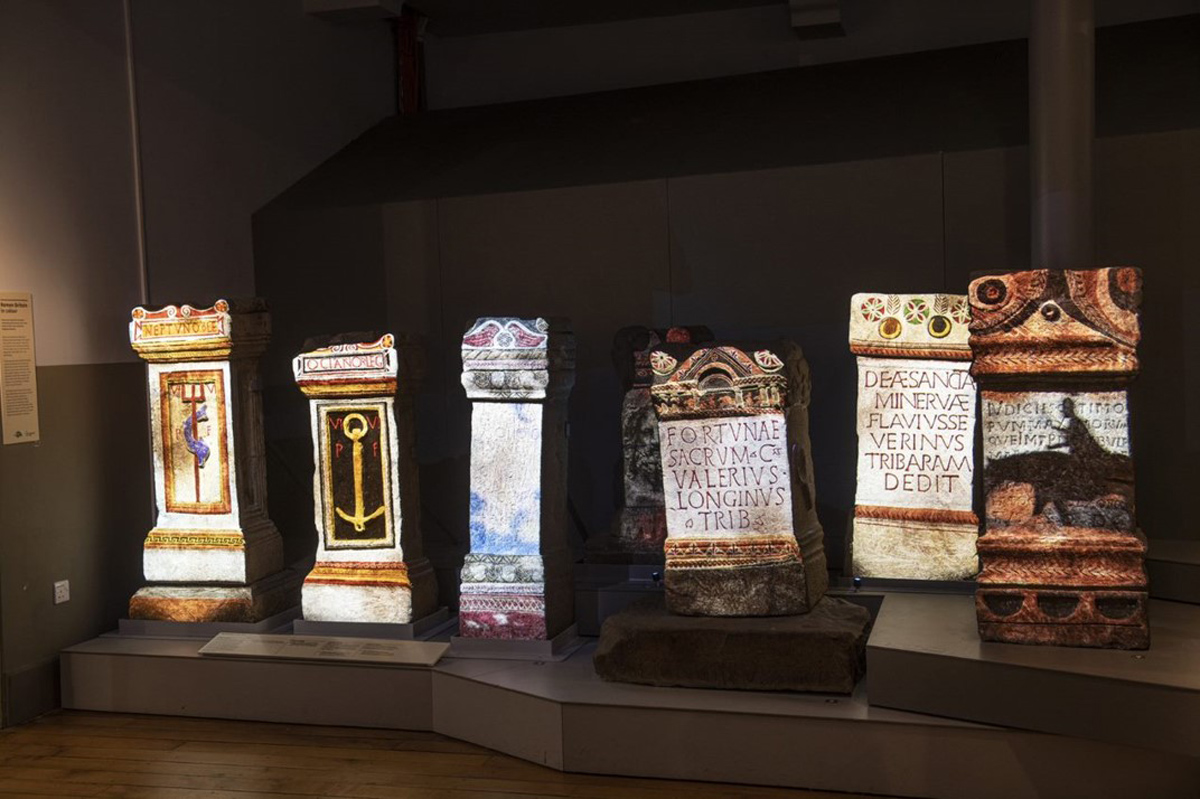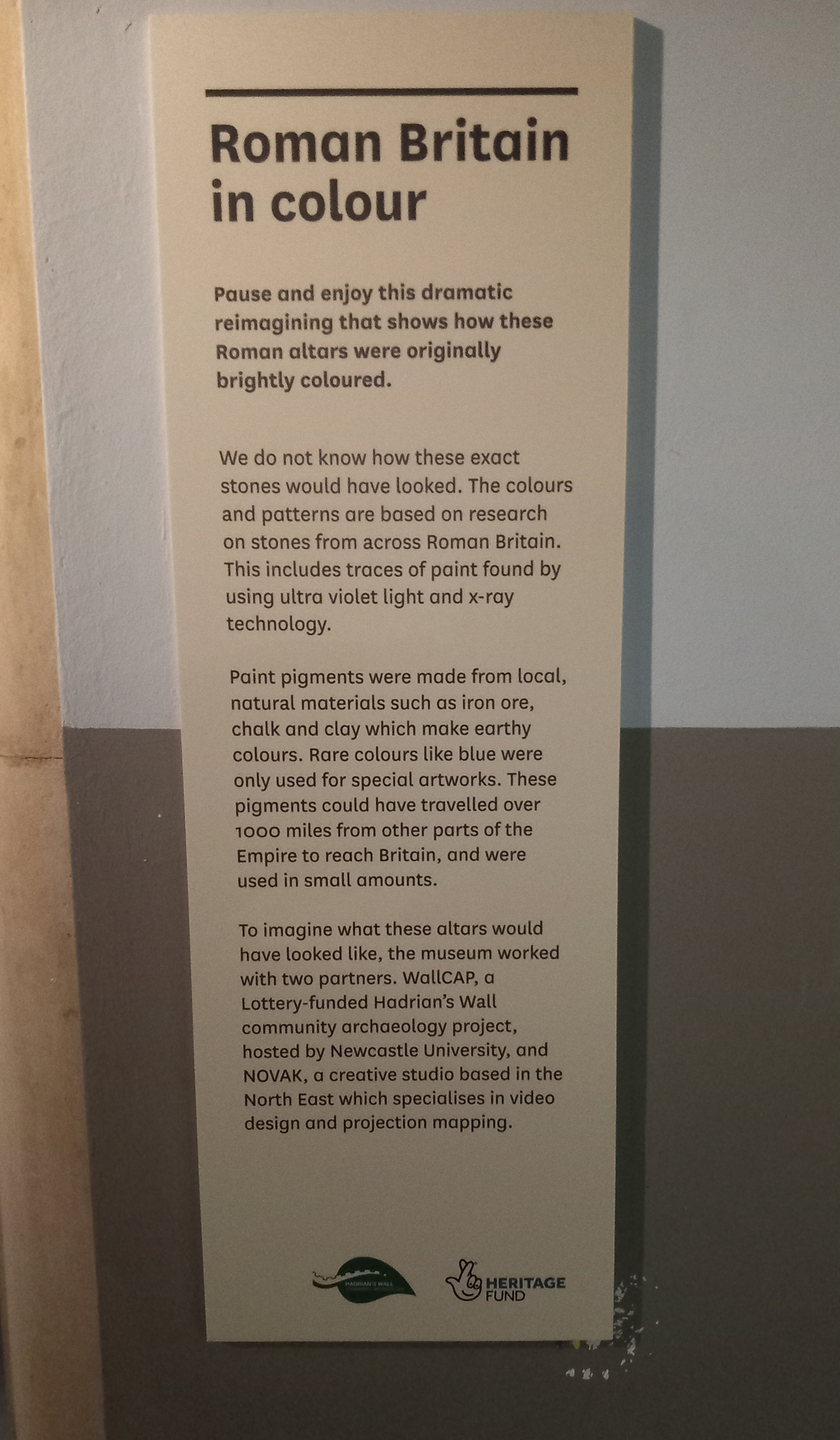Roman Britain in Colour is an initiative that uses the technique of projection mapping to enhance the display of a group of Roman altars in the Great North Museum: Hancock in Newcastle upon Tyne. The project sought to develop new interpretation in the museum’s Hadrian’s Wall Gallery, to improve the visitor experience, and enhance understanding of Roman altars. The use of projection mapping in museums has grown significantly over the past decade, becoming an important element in the interpretative strategies of many venues. Projection mapping can be defined as a practice which ‘consists of applying light whose geometry corresponds to a more or less complex surface of heterogeneous materials on which it is projected’ (Schmitt et al. 2020: xviii). Essentially, it allows images to be superimposed onto objects, or buildings, adding visual layers to their display without damaging them in any way. A further element to projection mapping is the possibility of using moving images to create dynamic displays (Kang 2018: 399).
Great North Museum: Hancock – Hadrian’s Wall Gallery
The Great North Museum: Hancock houses some of the most significant carved and inscribed stonework from Hadrian’s Wall. The Museum is home to the collection of the Society of Antiquaries of Newcastle upon Tyne and represents over 200 years of collecting material from the northern frontier of the Roman Empire (Hodgson 2013: 54–59). Elements of the Society’s collection are on display in the Hadrian’s Wall Gallery of the Museum, which was conceived of as a gateway to Hadrian’s Wall (Mills et al. 2013: 182). The scope of the collection, covering every major site along the Wall allows the Gallery to provide an overview of the whole monument and, with nearly 400,000 visitors a year, the Museum plays a significant role in the public understanding of the Wall.
This Gallery, along with the rest of the museum, opened to the public in 2009. Since this date, very little work has taken place to update the Gallery. In fact, some features of the original conception of the Gallery, including interactive elements, have been removed because they had significantly deteriorated over time. An opportunity to revisit some of the Gallery’s interpretation was provided by a collaboration with WallCAP, a Hadrian’s Wall community archaeology project run from Newcastle University’s School of History, Classics and Archaeology. WallCAP, a National Heritage Lottery funded initiative, had finances available to update aspects of the Hadrian’s Wall Gallery in the Great North Museum. As a result, WallCAP volunteers visited the museum in 2019 as part of a community consultation on the prospective redevelopment of elements of the Gallery. With a specific focus on the visitor experience, they identified strengths and weaknesses in the gallery. Their feedback on what they wanted to see, in terms of new interpretation, was crucial for our decision to use projection mapping.
One of the major criticisms of the Gallery that came out of the consultation was the fact that most visitors were likely be overwhelmed by the sheer quantity of carved and inscribed stonework. There is a significant presence of building inscriptions, tombstones, and altars that, despite providing valuable insights into Rome’s northern frontier, can be challenging for the general public to understand. In addition, the existing interpretation in the Gallery, including text labels and touch screens, was not considered adequate to engage audiences; the information did not provide any insights into, for example, the way, in which altars might have been used or their original appearance. In short, there is a large quantity of sandstone material in the Gallery which is hard for visitors to understand and appreciate without the benefit of specialist knowledge. There was a strong sense that many people were passing through the Gallery on their way to other areas in the Museum and missing the fascinating collections it housed. This issue is not unique to the Hadrian’s Wall Gallery in the Great North Museum. The Clayton Museum, at Chesters Roman Fort, on Hadrian’s Wall houses similar collections that are difficult for visitors to engage with, resulting in very short visits to the museum and a failure to engage with the collections (Petrelli and Roberts 2023: 9).
Projection Mapping in Museums
The decision to use projection mapping to highlight a selection of altars in the Gallery was informed by several factors. First of all, this approach has already been successfully used in the heritage sector (Georgescu Paquin 2020) and several museums have begun to explore its potential. The British Museum, for example, made use of projection mapping to highlight aspects of a series of Assyrian reliefs in the 2018 exhibition I am Ashurbanipal king of the world, king of Assyria (Brereton 2018). Here they worked in collaboration with DHA Designs, a London based lighting design consultancy and OPERA Amsterdam, a Dutch exhibition design company, to develop colourful and dynamic projected overlays on Assyrian relief sculpture (DHA Designs 2018; OPERA Amsterdam 2018). A clear advantage of using projection technology from a museum perspective is the fact that it does not damage the objects in any way (Georgescu Paquin 2020: 192). It is also easily changed, so that new evidence and ideas can be incorporated into an exhibit using existing projectors and just changing the display they are programmed to show.
A further consideration was the fact that the Great North Museum had previous experience of using projection for interpretation. For example, projection, alongside sound, is used in the Museum’s Egyptian Gallery, in an area that explains beliefs about the afterlife. Furthermore, the Museum had previously worked with Novak, a Newcastle-based design studio, to create projected animation for the Natural History Museum’s tour of the Dippy the dinosaur (Great North Museum 2016), which was exhibited at the Great North Museum in 2019 (Novak 2019). This was not a projection mapping project but it did highlight the potential of using projectors creatively to enhance museum interpretation. A final incentive to use projection mapping was the belief that this would provide the Museum with the best way of creating an impactful intervention within the available budget.
Colour on Ancient Sculpture
Our thinking behind making use of projection mapping was also based on recent work by museums and archaeologists to reinstate some of the lost colour from sculptures and inscriptions from the Greco-Roman world. It has long been understood that Greek and Roman carved and inscribed stonework would have originally been painted (Ridgway 1999: 105–7; Basso et al. 2023: 1–2). Most of this has been lost over time through post depositional processes such as weathering and pigment disintegration as well as over-zealous cleaning by museum staff (Bradley 2009: 431; Campbell 2020a: 179), however, on occasion there have been tantalising glimpses of original colour schemes. Ridgway (1999: 105–6), for example, points to the temple of Aphaia on the Greek island of Aegina, which was first excavated in 1811. Here traces of bright paintwork were visible on various elements of the building, including the friezes as well as the pediments and their sculptures, although they rapidly faded on contact with the air.
One of the most striking illustrations of the use of colour in sculpture from Rome’s northern frontier comes from the 1950 excavation of the Carrawburgh Mithraeum on Hadrian’s Wall (Figure 1). Here the excavators noticed hints of original pigmentation on an altar to Mithras set up by Marcus Simplicius Simplex (RIB 1546). There were, for instance, traces described as a ‘deep scarlet stain’ on the cloak of the figure of Mithras represented on the altar (Richmond and Gillam 1951: 38; Campbell 2020b: 102–103). This knowledge that the stonework was coloured informed the creation of a reconstruction of the Mithraeum at Carrawburgh that was displayed in the Museum of Antiquities on Newcastle University’s campus from 1960 until its closure in 2008 (Daniels 1989: 23; Allason-Jones 2009). The actual colour palette for the reconstruction was based on evidence from a range of Mithraea, including Dura on the Euphrates and Santa Maria di Capua Vetere (Daniels 1989: 23), but the excavators’ observations of original paintwork are highly likely to have also played a part.
The Mithraeum in the Museum of Antiquities is a relatively early example of an attempt by a museum to reconstruct coloured stonework from antiquity. More up to date interest and research in the use of polychromy on the sculpture of the ancient world, such as the Ny Carlsberg Glypotek’s Tracking Colour project (Carlsbergfondet, Date Unknown) has led to more reconstructions of coloured ancient statuary in museums and elsewhere (Barry 2020: 47). Recent museum-based examples include the British Museum’s 2015 exhibition Defining Beauty: The Body in Ancient Greek Art (Jenkins 2015) and the Metropolitan Museum of Art’s Chroma: Ancient Sculpture in Color, which opened in 2022 (Metropolitan Museum of Art 2022). Perhaps the most significant exhibition, certainly in terms of its impact, has been Bunte Götter. Die Farbigkeit antiker skulptur, or in the English speaking world Gods in Color, which has travelled to over 20 venues in Europe and North America and been seen by approximately three million people (Rose-Greenland 2016: 85–86; Østergaard 2019: 111). Closer to Hadrian’s Wall, English Heritage’s site museum at Corbridge displays a colour reconstruction of the tombstone of Flavinus (RIB 1172), a Roman cavalry standard-bearer of the ala Petriana. The use of colour reconstructions in varied museum contexts therefore had a significant impact on the decision to use projection mapping in the Hadrian’s Wall Gallery of the Great North Museum.
One additional aspect of the interest in polychromy in ancient sculpture, which has become more prominent in recent years, is the application of a range of scientific techniques, such as portable X-ray fluorescence (pXRF) and portable Raman spectrometry, deployed to provide deeper insights into the pigments used. These techniques can go some way towards accurately reinstating lost colours, no longer visible to the naked eye, on ancient sculpture. The extensive range of analytical approaches used by museums to deepen our understanding of ancient polychromy is demonstrated by work at the Metropolitan Museum of Art in New York on a Parian marble Attic funerary stele (Basso et al. 2023). Here a multidisciplinary team used a variety of techniques, including digital microscopy, X-ray fluorescence spectroscopy, and Raman spectroscopy to elucidate further the colour scheme of this funerary monument. Most of the research on polychromy on sculpture from antiquity has focussed on relatively high status marble sculpture, although the use of colour on other materials, including limestone and sandstone is recognised (Bradley 2009: 430). On Rome’s northern frontier this scientific approach is exemplified by Louisa Campbell’s museum-based research on stonework from the Antonine Wall and Hadrian’s Wall, which has yielded impressive results into the range of colours employed on Roman carved and inscribed stonework (2020a: 191; 2020b: 101). Her work has demonstrated how pigments including red lead, white lead, and yellow and red ochre were exploited to adorn relief sculptures from both Walls. Not surprisingly, the pigments identified are predominantly ones that could have been easily sourced locally, while the presence of pigments from elsewhere in the Empire is rare (Campbell 2020: 194). As a result of this research, our understanding of the colour palette utilised by artisans working in northern Britain has been significantly enhanced and the outcomes of this research directly informed the development of Roman Britain in Colour.
Roman Britain in Colour
Against this background, the decision was made to use projection mapping to create a new visually informative intervention in the Hadrian’s Wall gallery. The aim was to positively engage visitors with the objects on display and provide them with new insights into the nature of carved and inscribed stonework on Rome’s northern frontier. A tender for the work was produced and Novak, with their existing experience in the museum sector, were ultimately appointed to deliver the project. The ensuing process of developing ideas for the display was highly collaborative.
Both the museum and our academic partners in Newcastle University worked closely with Novak to develop concepts; always keeping in mind the feedback of the WallCAP volunteers. This interdisciplinary cooperation closely resembles the approach usually adopted by artists and illustrators involved in producing reconstruction drawings and paintings (Mills 2013: 3; Perry and Johnson 2014: 348–349). The final Roman Britain in Colour display was the product of extensive conversations between curators, archaeologists, and Novak, who each brought different skills and experience to the discussion. From the museum’s perspective, it would have been valuable to have additional input from the WallCAP volunteers at this stage of the project. Unfortunately, the timeframe involved meant that this was not possible. Nevertheless, our work with the volunteers highlights the value of co-creation and points the way to potential further long-term collaborative work.
Initially a group of seven altars was selected (Figure 2).1 These were mainly chosen because of their position in the Gallery. An important consideration was providing room for the projector’s throw: the distance needed for the projectors effectively to project an image onto the altars. There were several areas where we could have made use of the technology but the seven altars selected are in the most accessible position to attract visitors’ attention. They are in one corner of the Hadrian’s Wall Gallery in an area that explores religious belief on the Wall. The seven altars represent a number of different deities and provide visitors with a sense of some of the gods and goddesses encountered on the frontier, including a probable native deity Antenociticus (Aldhouse-Green 2018: 73–75). None of these altars have been scientifically analysed for traces of original pigmentation, and the colours we used to recreate a sense of what they may have originally looked like were based on evidence from similar altars from northern Britain. Extensive use was made of the analytical work by Campbell (2020a; 2020b) which covers similar material from the Antonine Wall and Hadrian’s Wall. The final projection mapping, as well as giving an impression of the colours used, also made use of additional animation to bring the altars to life in an imaginative way. The altars to Neptune and Oceanus, from the River Tyne, both included projected aquatic imagery such as crabs and seaweed to emphasise the god’s watery nature. The altar to Fortuna incorporated a representation of a libation being poured onto an altar, demonstrating one of the ways an altar may have been used by a worshipper in the Roman period. The projection on the altars runs for about three minutes providing a short display of colours and animation. At the end, the colours gradually fade, alluding to processes of decay that led to the altars’ current lack of pigmentation.
The projection mapping on the altars (Figures 3, 4, 5) acts as a stimulus to imaginative responses on the part of museum visitors. It provides what can be described as a ‘jolt of unfamiliarity’ (Rees Leahy 2014: 288) to make the viewer reflect on and reassess their assumptions about Roman sculpture. The recontextualisation of the altars through projection mapping acts as a spark for the imagination, creating a dialogue between the visitor and the altars (Petrelli and Roberts 2023: 1). The perception that statuary and stonework from antiquity was unpainted and austere is strongly ingrained in many visitors (Ridgway 1999: 103; Bradley 2009: 427); any museum display that highlights polychromy will challenge this.
Frequently, museums rely on interpretative strategies where supporting text labels are seen as essential for conveying information about objects (Dudley 2010: 4). Projection-based interpretation moves beyond this standard approach to explaining objects (Mills 2013: 1), allowing visitors to develop their own responses without relying on descriptive labels. The impact of coloured altars, not least the way in which text on the altars becomes easier to read when it is picked out in red paint on a white background, is one of the first things that becomes apparent from viewing Roman Britain in Colour. Not only is the original appearance of the altars suggested through the projection, but also the use of animation provides a sense of how the altars functioned and the nature of the gods they were dedicated to. Projection mapping can be a narrative technique, telling museum visitors a story as well as alluding to the appearance of material in the past. Here it acts more as an interpretative tool than a static representation of ancient polychromy.
In addition, the fading of the projection encourages visitors to make their own inferences about the kinds of processes that led to the loss of colour on the altars. This knowledge can be taken from the altars that are highlighted by projection mapping, and used to inform an understanding of altars and stonework elsewhere in the Hadrian’s Wall Gallery.
The group of seven altars gives a welcome injection of colour into the Hadrian’s Wall Gallery. They lift the overall feel of the Gallery, providing a change of tone from the plain inscribed and carved sandstone that dominates much of the space. The aesthetic impact encourages visitors to stop, look, and perhaps contemplate rather than make their way quickly through the Gallery to see what else the Museum has to offer. In addition, they act as a corrective to the often-expressed view that Roman Britain was a drab place. This perspective may, to some extent, have been engendered by reconstruction artists, in particular Alan Sorrell, who frequently chose, for artistic effect, to portray the province as dark and gloomy (Pitts 2005: 18–19; Perry and Johnson 2014: 344; Sorrell and Sorrell 2018: 174).
Problems
Obviously, the interpretation of these seven Roman altars through projection mapping is not without issues. The very presence of the altars in the Museum’s Hadrian’s Wall Gallery means that they are divorced from their original contexts and are an artificial grouping (Skeates and Day 2019: 12; Petrelli and Roberts 2023: 1). This dissociation from their original contexts is further amplified by the fact that they are from different sites and are likely to represent a range of dates. The altars to Oceanus (RIB 1320) and Neptune (RIB 1319), for example, come from the River Tyne at Newcastle and are associated with the site of the Roman bridge (Tomlin 2018: 93), while the altar to Antenociticus (RIB 1329) comes from a temple site outside the fort at Benwell (Aldhouse-Green 2018: 73–75). In the case of some of these altars, we do not know their original contexts at all. The Wallsend altar to Jupiter Optimus Maximus (RIB 1299), for instance, was discovered in an allotment some 275 m west of the fort site.
Furthermore, the term ‘reconstruction’, which is often applied to displays that are intended to evoke the past, has been criticised (Blockley 1999: 15; Stone and Planel 1999: 1-2; Hedegaard and Brøns 2019: 8). The implication behind the use of this term and similar ones, such as ‘restoration’ and ‘re-creation’, is that an accurate view of the past is being presented to the museum visitor (Hedgaard and Brøns 2019: 20). This is clearly not the case. As with any reconstruction there is no way that it can be considered ‘a once-and-for all authoritative view of the past’ (Greaney 2013: 37). Archaeological interpretation should rather be seen as an ongoing process that changes over time as new evidence and techniques lead to a deeper understanding of the past (Rasmussen and Grønnow 1999: 142). Stone and Planel (1999: 1–2) observe that the past cannot be reconstructed, instead it is continually constructed by individuals and groups who interact with it and this interaction is determined by a number of factors, such as social and cultural background. Several alternative terms have been proposed that imply less definitive certainty about a reconstruction. These include ‘approximations’ (Østergaard 2017: 165) and ‘reconstructive representations’ (Hedegaard and Brøns 2019: 8). For our work, we chose the term ‘reimagining’, and this is how Roman Britain in Colour is referred to in the text panel that accompanies the projection mapping. This acknowledges the speculative nature of the project and hopefully signposts museum audiences to the fact that we are not presenting the absolute, final truth.
An additional criticism is the fact that the colours applied to the altars do not derive from any direct scientific analysis of the altars. For pragmatic reasons we took scientific data from other similar altars and applied it to this group. This makes the display, in some respects, a disingenuous one, particularly if a key element in any archaeological ‘reconstruction’ is the desire to ‘ensure that visitors are not misled and that they receive as accurate an impression as possible of the Roman World’ (Mills 2013: 5). Nevertheless, this can be balanced against the desire to use this reimagining to inform our audience of an aspect of Roman carved stonework they may not have considered. The role of this type of display is to inspire visitors (Figure 6), while perhaps challenging and changing their perceptions of an aspect of Roman material culture (Perry and Johnson 2014: 324).
A broader criticism might be that a display of this nature represents the dumbing down or ‘Disneyfication’ of museum interpretation (Mills 2013: 1). This can be regarded as part of a trend where museums have moved from being repositories for conserving and displaying material from the past to being venues whose primary function is education and entertainment (Sontag 2003: 107). In response to this criticism, it should be noted that museums, particularly those that receive public funding, have a responsibility to make their collections accessible to as broad an audience as possible. They have to consider all their audiences and not just a small minority of specialists. All museum interpretation is reliant on choices made by curators and other museum staff and it is nearly always impossible, given the constraints of available space, to tell the full story of an object in a gallery context. At the same time, the power of strong visual interpretation to provoke an imaginative response on the part of the visitor can enrich their experience and understanding in ways that more traditional interpretation cannot. Sandra Dudley (2010: 8) talks about the impact of affective emotional responses to museum objects, observing that, ‘museums’ preference for the informational over the material and for learning over personal experience … may risk the production of displays which inhibit and even preclude such affective responses’. There has certainly been a development in understanding the need to provide audiences with ‘emotionally engaging experiences’ (Economou et al. 2018: 1) and Roman Britain in Colour can be seen as a display that prioritises emotional responses on the part of visitors. There is some textual interpretation to accompany the display, but this is secondary; most visitors will see the projection before coming to the text. Indeed the visual impact of the projection has the potential to overshadow the accompanying text (Hedegaard and Brøns 2020: 22), while the extent to which museum audiences read text panels is also questionable (Reitstätter et al. 2022). A final point to consider is the way non-verbal interpretation can often say more and be more accessible than a text panel (Greaney 2013: 32). Reading the written word requires purposeful engagement (Lowenthal 1985: 245), whereas the impression of a visual reimagining is more immediate. The reach of non-textual, visual interpretation goes much further than a museum label, which usually only conveys a limited amount of information and is certainly not accessible to all visitors.
Roman Britain in Colour does not necessarily represent a response to the marked ‘sensory turn’ in archaeology that has been noted from the 1990s onwards (Skeates and Day 2019: 1–4). In fact, it can be regarded as a continuation of an occularcentric method of museum display; an approach that dominates the vast majority of gallery interpretation (Dudley 2010: 8; Fahlander and Kjellström 2010: 1; Skeates and Day 2019: 12). The altars in the display are dissociated from the sounds, smell, taste, and touch of the past, which would have informed any interaction with them (Brøns 2019: 318). Museums have long been aware of the use of various sensory methodologies in their interpretation and both touch and sound have frequently been employed, alongside, albeit less frequently, smell. The Jorvik Viking Centre provides an excellent illustration of some of these varied approaches in action (Addyman and Gaynor 1984: 11–13) and the Great North Museum: Hancock certainly makes use of sound to provide an additional dimension to its interpretation. Despite being an occularcentric methodology, the projection mapping employed for Roman Britain in Colour opens up an area of the visual representation of Rome’s northern frontier that is relatively neglected. It introduces the museum audience to the possible range of colours that were utilised to adorn altars and other carved and inscribed stonework. The power of such imaginative reconstructions to make museum audiences rethink long held assumptions and challenge their understanding of material culture should not be underestimated (Perry and Johnson 2014: 324).
Conclusion
To date there have been no formal attempts to evaluate the impact of Roman Britain in Colour but informal comments made by museum visitors and the academic community have been overwhelmingly positive. Frequently visitors have remarked on the fact that they were not aware of the use of pigment on Roman carved stonework. The projection mapping animation has also been welcomed by many who appreciate the element of drama introduced into the gallery. Dwell times in front of the altars also appear to be greatly extended when compared to previous visitor behaviour in the gallery. Popular archaeology journals, including Current Archaeology (Blair 2022) and Antike Welt (2021), picked up on the display relatively quickly, further indicating the impact the project has had beyond the context of the museum.
Undoubtedly, Roman Britain in Colour does not provide a comprehensive insight into the scientific processes behind the reimagining of the altars. In the space available it would be impossible to practically cover this in any meaningful depth. There is often a tension between providing audiences with an engaging experiences and communicating archaeological evidence (Economou et al. 2018: 7); finding the right blend between these different perspectives is difficult and will inevitably leave some visitors dissatisfied. As already stated, museums have to be selective in what they present to their audiences and a focus on challenging a widely held perception of Roman carved stonework was the key point the display was intended to communicate. Østergaard (2017: 165) correctly observes that a ‘research-based reconstruction — despite its limitations — is nearer to a historical reality than any faded original. The impact of this on “ordinary” viewers cannot be overestimated’. It is also possible to support gallery interpretation elsewhere and, in this case, a short blog was written to provide more context for the project for anyone interested (Parkin 2021).
Overall, Roman Britain in Colour can be viewed as a success, which the museum can build on with further projection mapping projects, as well as more in-depth interpretation relating to the archaeological science behind it. Archaeological ‘reconstructions’ are very susceptible to academic criticism (Blockley 1999: 15), but are popular with the wider public because they provide an understanding of the past that would otherwise be inaccessible to many. Roman Britain in Colour underlines the impact of strong visual interpretation to provoke an affective response in museum visitors, as well as creating a memorable experience. Furthermore, the intervention has drawn attention to an area of the Great North Museum that is usually overlooked. The fact that it has focused a great deal of attention on epigraphic evidence from Hadrian’s Wall is testimony to the efficacy of projection mapping as an interpretative technique.
Abbreviations
RIB – Roman Inscriptions in Britain. Accessible at: https://romaninscriptionsofbritain.org/
Notes
- The seven altars and their respective sites are: Fortuna redux (Risingham), RIB 1210; Antenociticus (Benwell), RIB 1329; Jupiter (IOM) and the Mother goddesses (Binchester), RIB 1030; Oceanus (River Tyne at Newcastle), RIB 1320; Neptune (River Tyne at Newcastle), RIB 1319; Jupiter Optimus Maximus (Wallsend), RIB 1299; Minerva (High Rochester), RIB 1267. [^]
Acknowledgements
Roman Britain in Colour was a highly collaborative project, involving a number of organisations and individuals. I want to take the opportunity to thank my colleagues at the Great North Museum: Hancock, Novak, the WallCAP volunteers, and Rob Collins, without whom the gallery intervention would not have been realised. I would also like to thank Sally Waite and Jacob Parkin for their help in the preparation of this paper.
Competing Interests
The author has no competing interests to declare.
References
Addyman, Peter and Anthony Gaynor. 1984. The Jorvik Viking Centre. An experiment in archaeological site interpretation. The International Journal of Museum Management and Curatorship 3: 7–18. DOI: http://doi.org/10.1016/0260-4779(84)90027-X
Aldhouse-Green, Miranda. 2018. Sacred Britannia. The Gods and Rituals of Roman Britain. London: Thames and Hudson.
Allason-Jones, Lindsay. 2009. The Museum of Antiquities: a retrospective. Archaeologia Aeliana 38(5): 1–21. DOI: http://doi.org/10.5284/1061203
Antike Welt. 2021. Römische Altäre in bunten Farben. Available at: https://antikewelt.de/2021/11/26/roemische-altaere-in-bunten-farben/ [Last accessed 4 December 2023].
Barry, Fabio. 2020. Painting in Stone. Architecture and the Poetics of Marble from Antiquity to the Enlightenment. New Haven and London: Yale University Press.
Basso, Elena, Federico Carò, and Dorothy H. Abramitis. 2023. Polychromy in ancient Greek sculpture: new scientific research on an Attic funerary stele at the Metropolitian Museum of Art. Applied Sciences 13(5): 1–16. DOI: http://doi.org/10.3390/app13053102
Blair, Hazel. 2022. A trick of the light: the Great North Museum, January 2, 2022. Available at: https://the-past.com/shorts/the-picture-desk/a-trick-of-the-light-the-great-north-museum-hancock-newcastle/ [Last accessed 4 December 2023].
Blockley, Marion. 1999. Archaeological reconstructions and the community in the UK. In: Peter Stone and Philippe Planel (eds). The Constructed Past: Experimental Archaeology, Education and the Public. London: Routledge: 15–32.
Bradley, Mark. 2009. The importance of colour on ancient marble sculpture. Art History 32: 427–457. DOI: http://doi.org/10.1111/j.1467-8365.2009.00666.x
Brereton, Gareth (ed.). 2018. I am Ashurbanipal: King of the World, King of Assyria. London: Thames and Hudson.
Brøns, Cecilie. 2019. Ancient colours: perspectives and methodological challenges. In: Shiyanthi Thavapalan and David Alan Warburton (eds). The Value of Colour. Material and Economic Aspects in the Ancient World. Berlin Studies of the Ancient World 70. Berlin: Edition Topoi: 311–337. DOI: http://doi.org/10.17171/3-70
Campbell, Louisa. 2020a. Polychromy on the Antonine Wall distance sculptures: non-destructive identification of pigments on Roman reliefs. Britannia 51: 175–201. DOI: http://doi.org/10.1017/S0068113X20000124
Campbell, Louisa. 2020b. Monuments on the margins of empire: the Antonine Wall sculptures. In: David J. Breeze and William S. Hanson (eds). The Antonine Wall. Papers in Honour of Professor Lawrence Keppie. Oxford: Archaeopress: 96–109.
Carlsbergfondet. Date Unknown. Tracking Colour – Polychromy of the Ancient World. Project History. Available at: https://www.trackingcolour.com/about/project-history [Last accessed: 4 December 2023].
Daniels, Charles. 1989. Mithras and His Temples on the Wall. Newcastle upon Tyne: Society of Antiquaries of Newcastle upon Tyne.
DHA Designs. 2018. Exhibitions – I am Ashurbanipal: King of Assyria, King of the World. Available at https://www.dhadesigns.com/projects/museum-and-heritage/exhibitions/I-Am-Ashurbanipal:-King-of-Assyria,-King-of-the-World/141 [Last accessed 4 December 2023].
Dudley, Sandra H. 2010 Museum materialities: objects, sense and feeling. In: Sandra H. Dudley (ed.). Museum Materialities. Objects, Engagements, Interpretations. London: Routledge: 1–17.
Economou, Maria, Hilary Young, and Emilia Sosnowska. 2018. Evaluating emotional engagement in digital stories for interpreting the past. The case of the Hunterian Museum’s Antonine Wall EMOTIVE experiences. 3rd Digital Heritage International Congress (DigitalHERITAGE) held jointly with 2018 24th International Conference on Virtual Systems & Multimedia (VSMM 2018), San Francisco, CA, USA, 2018: 1–8. DOI: http://doi.org/10.1109/DigitalHeritage.2018.8810043
Fahlander, Fredrik and Anna Kjellström. 2010. Beyond sight: archaeologies of sensory perception. In: Fredrik Fahlander and Anna Kjellström (eds). Making Sense of Things. Archaeologies of Sensory Perception. Stockholm: Department of Archaeology and Classical History, Stockholm University: 1–14.
Georgescu Paquin, Alexandra. 2020. Heritage, mediation through projection mapping. In: Daniel Schmitt, Marine Thébault, Ludovic Burczykowski (eds). Image Beyond the Screen. Hoboken, NJ: Wiley. DOI: http://doi.org/10.1002/9781119706847.ch11
Greaney, Susan. 2013. Reconstruction drawings: illustrating the evidence. In: Nigel Mills (ed.). Presenting the Romans. Interpreting the Frontiers of the Roman Empire. Woodbridge: Boydell Press: 31–39.
Great North Museum, 2016. Dippy the Diplodocus is coming to the Great North Museum: Hancock, 15 November 2016. Available at https://greatnorthmuseum.org.uk/dippy-the-diplodocus-is-coming-to-the-great-north-museum-hancock [Last accessed: 4 December 2023].
Hedegaard, Signe Buccarella and Cecilie Brøns. 2019. Lost in translation: an introduction to the challenging task of communicating long-lost polychromy on Graeco-Roman marble sculptures. Analecta Romana Instituti Danici 44: 7–28.
Hodgson, Nick. 2013. Hadrian’s Wall. In: David Breeze (ed.). The Society of Antiquaries of Newcastle upon Tyne. 1813 – 2013. Newcastle upon Tyne: Society of Antiquaries of Newcastle upon Tyne.
Jenkins, Ian (ed.). 2015. Defining Beauty: The Body in Ancient Greek Art. London: Thames and Hudson.
Kang, Yiyun. 2018. CASTING: site specific projection-mapping installation. Leonardo 51(4): 399–404. DOI: http://doi.org/10.1162/leon_a_01650
Lowenthal, David. 1985. The Past is a Foreign Country. Cambridge: Cambridge University Press.
Metropolitan Museum of Art. 2022. Chroma: Ancient Sculpture in Color. Available at https://www.metmuseum.org/exhibitions/chroma [Last accessed: 4 December 2023].
Mills, Nigel. 2013. Presenting the Romans – issues and approaches to interpretation. In: Nigel Mills (ed.). Presenting the Romans. Interpreting the Frontiers of the Roman Empire. Woodbridge: Boydell Press: 1–10.
Mills, Nigel, Tim Padley, John Scott, Lucie Branczik, and Genevieve Adkins. 2013. Applying the Hadrian’s Wall interpretation framework. In: Nigel Mills (ed.). Presenting the Romans. Interpreting the Frontiers of the Roman Empire. Woodbridge: Boydell Press: 181–192.
Novak. 2019. Dippy on Tour: Great North Museum – Audio Visual Museum Installation. Available at https://novak.uk/work/dippy-on-tour-great-north-museum/ [Last accessed 4 December 2023].
OPERA Amsterdam. 2018. I am Ashurbanipal, British Museum, London (UK), 2018-2019. Available at https://opera-amsterdam.nl/britishmuseum-iamashurbanipal [Last accessed 4 December 2023].
Østergaard, Jan Stubbe. 2017. Colour shifts: on methodologies in research on the polychromy of Greek and Roman sculpture. Proceedings of the Danish Institute at Athens 8(8): 149–175. DOI: http://doi.org/10.2307/j.ctv3405qph.8
Østergaard, Jan Stubbe. 2019. “Reconstruction” of the polychromy of ancient sculpture: a necessary evil? Technè 48: 110–119. DOI: http://doi.org/10.4000/techne.2656
Parkin, Andrew. 2021. Why Roman Stones Were More Colourful Than You Realised…, November 12, 2021. Available at https://twmuseumsandarchives.medium.com/why-roman-stones-were-more-colourful-than-you-realised-a18ff7daaece [Last accessed: 4 December 2023].
Perry, Sara and Matthew Johnson. 2014. Reconstruction art and disciplinary practice: Alan Sorrell and the negotiation of the archaeological record. Antiquaries Journal 94: 323–352. DOI: http://doi.org/10.1017/S0003581514000249
Petrelli, Daniela and Andrew Roberts. 2023. Exploring digital means to engage visitors with Roman culture: virtual reality vs. tangible interaction. Journal on Computing and Cultural Heritage 16(4): Article 73. DOI: http://doi.org/10.1145/3625367
Pitts, Mike. 2005. Hysteria, gloom and foreboding [Allan Sorrell at Stonehenge]. British Archaeology 83: 16–19.
Rees Leahy, Helen. 2014. Incorporating the period eye. Spectators at exhibitions of exhibitions. The Senses and Society 9(3): 284–295. DOI: http://doi.org/10.2752/174589314X14023847039836
Reitstätter, Luise, Karolin Galter, and Flora Bakondi. 2022. Looking to read: how visitors use exhibit labels in the art museum. Visitor Studies 25(2): 127–150. DOI: http://doi.org/10.1080/10645578.2021.2018251
Richmond, Ian, A. and John P. Gillam. 1951. The temple of Mithras at Carrawburgh. Archaeologia Aeliana 29(4): 1–92.
Ridgway, Brunilde Sismondo. 1999. Prayers in Stone. Greek Architectural Sculpture Ca. 600 – 100 B.C.E. Berkeley: University of California Press.
Rose-Greenland, Fiona. 2016. Color perception in sociology: materiality and authenticity at the Gods in Color show. Sociological Theory 34(2): 81–105. DOI: http://doi.org/10.1177/0735275116648178
Schmitt, Daniel, Marine Thébault, and Ludovic Burczykowski. 2020. Introduction. In: Schmitt, Daniel, Marine Thébault, and Ludovic Burczykowski (eds). Image Beyond the Screen. Hoboken, NJ: Wiley: xvii–xix. DOI: http://doi.org/10.1002/9781119706847
Skeates, Robin and Jo Day. 2019. Sensory archaeology. Key concepts and debates. In: Robin Skeates and Jo Day (eds). The Routledge Handbook of Sensory Archaeology. London: Routledge: 1–17. DOI: http://doi.org/10.4324/9781315560175-1
Sontag, Susan. 2003. Regarding the Pain of Others. London: Penguin.
Sorrell, Julia and Mark Sorrell. 2018. Alan Sorrell. The Man who Invented Roman Britain. Oxford: Oxbow. DOI: http://doi.org/10.2307/j.ctv13pk6rw
Stone, Peter and Phillipe Planel. 1999. Introduction. In: Peter Stone and Philippe Planel (eds). The Constructed Past. Experimental Archaeology, Education and the Public. London: Routledge: 1–14.
Tomlin, Roger. 2018. Britannia Romana: Roman Inscriptions and Roman Britain. Oxford: Oxbow. DOI: http://doi.org/10.2307/j.ctvh1dvdr
